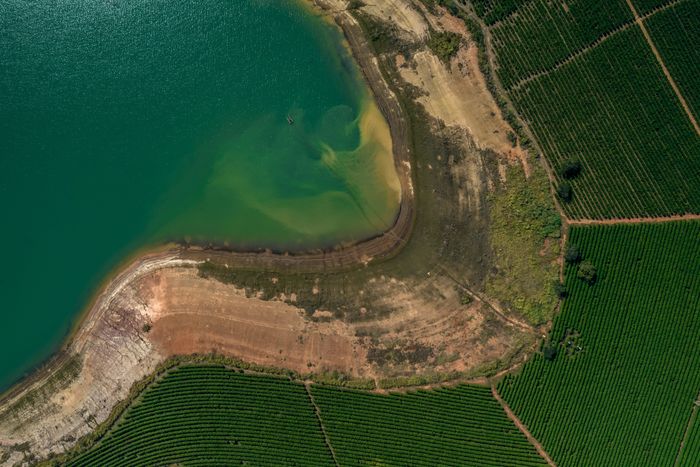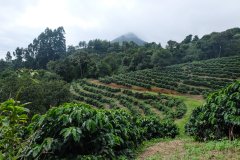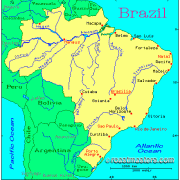Flavor characteristics of coffee beans in Sao Paulo, Brazil 2021 the yield of Brazilian coffee decreased due to drought
After a record harvest in 2020, Brazil is likely to see one of the worst declines in coffee production in 2021.
The drought brought by La Nina has hit new crops during the critical flowering period and is likely to depress the yield of Brazilian coffee.

In the course of Brazil's history and economic development, coffee cultivation in Brazil has undergone significant changes, especially in terms of production location. Coffee cultivation in Brazil began in the northern region in the 18th century and later moved towards Rio de Janeiro and Sao Paulo (Paraiba along the valley). Around 1850, planting quickly spread to Serra da Mantiqueira and Santos. Later, in the 20th century, coffee cultivation continued to expand to S ã o Paulo and the southern states of Minas Gerais, Esp í rito Santo, Parana, and even into the northern part of Brazil, in the state of Lando. Throughout the expansion period, the Brazilian economy as a whole was closely integrated with the coffee economy, and until the mid-1990s, the coffee market was highly regulated by the Brazilian federal government.
Brazil, the world's largest coffee producer, is now at the end of its two-year cycle. Even so, Sao Paulo is an important coffee producing area, and some farmers and exporters now expect production to be 20% to 30% lower than normal. This complements the usual 11% year-end decline, according to Gro's analysis of the past seven biennial production cycles. Brazil produced 6800 million bags (60 kg / bag) of raw coffee in 2020, an all-time high.
The rise in the price of Arabica coffee highlights the uncertainty facing Brazilian crops. The ICO composite index rose 9% in February to close at 128.34 cents per pound. The ICE May coffee futures contract has risen nearly 15 per cent in the past year. Brazilian coffee crops usually bloom between November and February, the most recent year when major coffee-producing regions such as Minas Gerais, Esp í rito Santo, S ã o Paulo and Parana all experienced drought Gro's Rainfall Monitor showed that Parana experienced the driest September on record.

The coffee crop of 2021 began to be harvested in May, but the results are worryingly weak.
According to relevant data, the possibility of a return to La Nina will affect the harvest of crops in Brazil and the United States.
While the destruction of La Nina in 2020 and 21 continues to disrupt global agricultural supply chains, climate experts warn that global weather events are likely to recur later this year.
Important Notice :
前街咖啡 FrontStreet Coffee has moved to new addredd:
FrontStreet Coffee Address: 315,Donghua East Road,GuangZhou
Tel:020 38364473
- Prev

Coffee pot in the world-the historical story of coffee bean cultivation in Brazil accounts for 1/3 of the world coffee bean output.
What do you think of when you hear about the South American country of Brazil? Some people will think of Carnival, its celebratory atmosphere, noisy fun and bright colors. Others think of the Amazon rainforest, which is 60% in Brazil. And I thought of coffee. As we all know, coffee is one of the most important industries in Brazil, which is why Brazil is called the world coffee pot.
- Next

Brazil's coffee bean production ranks first in the world Arabica coffee bean producing area coffee consumption new model
Brazil's coffee production is expected to exceed 61.6 million 60-kilogram bags by 2020, up from 49.3 million bags a year ago. Coffee crops are characterized by a biennial effect on harvest yields, with very high yields one year followed by relatively low yields. 2020 is the so-called positive double year. Brazil is by far the world's largest producer of coffee, while in the domestic sector the commodity accounts for 20 per cent
Related
- Detailed explanation of Jadeite planting Land in Panamanian Jadeite Manor introduction to the grading system of Jadeite competitive bidding, Red bid, Green bid and Rose Summer
- Story of Coffee planting in Brenka region of Costa Rica Stonehenge Manor anaerobic heavy honey treatment of flavor mouth
- What's on the barrel of Blue Mountain Coffee beans?
- Can American coffee also pull flowers? How to use hot American style to pull out a good-looking pattern?
- Can you make a cold extract with coffee beans? What is the right proportion for cold-extracted coffee formula?
- Indonesian PWN Gold Mandrine Coffee Origin Features Flavor How to Chong? Mandolin coffee is American.
- A brief introduction to the flavor characteristics of Brazilian yellow bourbon coffee beans
- What is the effect of different water quality on the flavor of cold-extracted coffee? What kind of water is best for brewing coffee?
- Why do you think of Rose Summer whenever you mention Panamanian coffee?
- Introduction to the characteristics of authentic blue mountain coffee bean producing areas? What is the CIB Coffee Authority in Jamaica?

